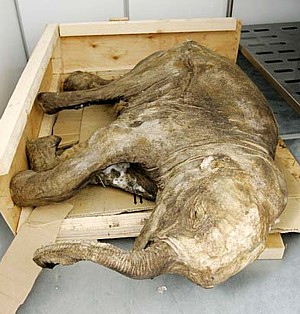

Posted on 04/17/2009 11:08:33 PM PDT by JoeProBono
Only a handful have ever been found before. But none like her. Her name is Lyuba. A 1-month-old baby mammoth, she walked the tundra about 40,000 years ago and then died mysteriously. Discovered by a reindeer herder, she miraculously re-appeared on a riverbank in northwestern Siberia in 2007. She is the most perfectly preserved woolly mammoth ever discovered. And she has mesmerized the scientific world with her arrival - creating headlines across the globe. Everyone wants to know... how did she die? What can she tell us about life during the ice age and the Earth's changing climate? Will scientists be able to extract her DNA, and what secrets will it uncover?
(Excerpt) Read more at channel.nationalgeographic.com ...


Incredible.


Are they good to eat?
GLOBAL WARMING!!!!!

I heard about this find. First look at photos...Astonishing!
However tusks and teeth are readily available for sale. There were so many mammoths that their tusks were used to build houses.


Mastodons
The American mastodon (scientific name Mammut americanum) roamed North America from at least 3.75 million to 11,000 years ago. Mastodons, along with mammoths and modern elephants, are members of the order Proboscidea. As adults they stood between 2.5 and 3 meters (8-10 feet) at the shoulder and weighed betweeen 3500 and 5400 kilograms (4-6 tons).
Mastodons became extinct approximately 11,000 years ago. Today, paleontologists are trying to understand why.
Mammoths
Three species of mammoths (genus Mammuthus) lived on the mainland of the United States at the end of the last Ice Age. These were the Columbian mammoth (M. columbi), Jefferson's mammoth (M. jeffersonii), and the woolly mammoth (M. primigenius). Of these, Jefferson's mammoth and the woolly mammoth have been identified from the midwestern U.S.
As adults these late-occuring mammoths stood between about 3 and 3.7 meters (10-12 feet) at the shoulder and weighed between 5500 and 7300 kilograms (6-8 tons).
Approximately 1.5 to 1.8 million years ago the first mammoths entered North America. These mammoths came from Eurasia, crossing the Bering Strait at a time when sea level was lower than today. The first mammoths from Eurasia belonged to a species called M. meridionalis. The descendants of this species of mammoth included both the Columbian and Jefferson's mammoths. The woolly mammoths evolved in Eurasia and came over the Bering Strait much later (perhaps less than 500,000 years ago). Approximately 11,000 years ago all species of mammoths went extinct in North America.


The difference in the size of the ears is interesting. Probably a climate adaptation. Although the Indian elephant, not shown, has disproportionately smaller ears than the African elephant which is a larger beast, I would suspect it's not much cooler in India.
Speaking of climate, it is even more interesting to speculate why these beasts disappeared from North America about 11,000 years ago. The Wikipedia article cites the possibility that humans hunted them to extinction but seems to lean toward the view that climate change-global warming 11,000 years ago-led to their extinction.




The Indian elephants are largely found in hillside rainforest fringes, be they along the Himalayan foothills in the north and north-east, or the Western Ghats, in the south.
These places are much cooler than the range that African elephants occupy.
By the way, I had also watched a Nat Geo program where they mentioned the Indian elephant being the closest genetic living relative to the Mammoth.
There's also a theory that a meteor strike caused their extinction. The lack of a crater is attributed to the meteor hitting the ice sheet that covered northern North America at the time.
Leastwise, that's the theory.
Disclaimer: Opinions posted on Free Republic are those of the individual posters and do not necessarily represent the opinion of Free Republic or its management. All materials posted herein are protected by copyright law and the exemption for fair use of copyrighted works.